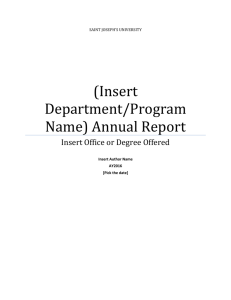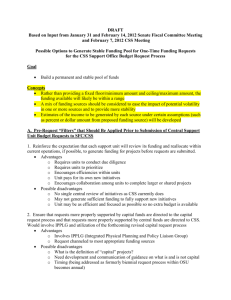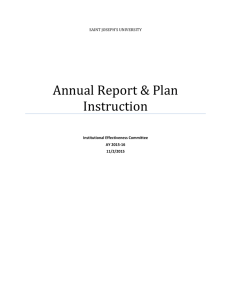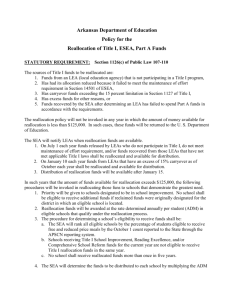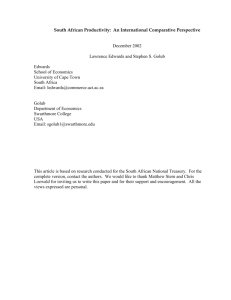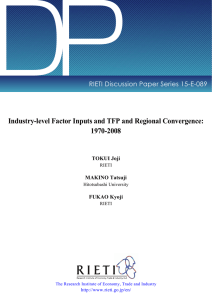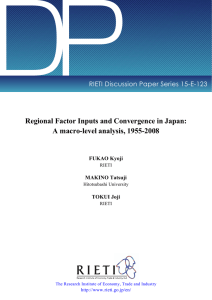Productivity and Growth of Japanese Prefectures
advertisement
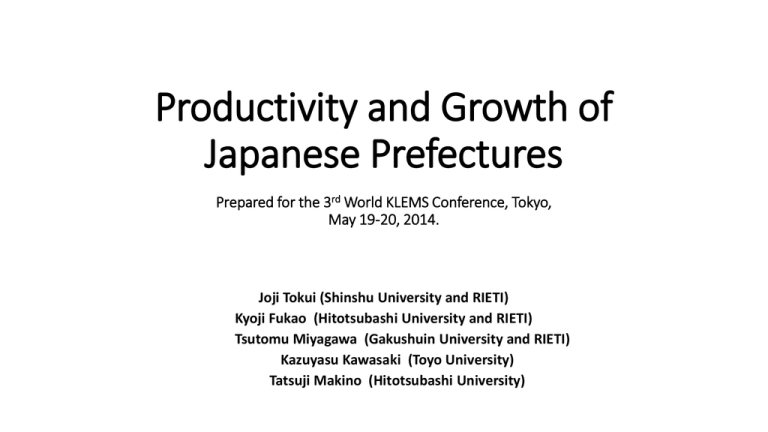
Productivity and Growth of Japanese Prefectures Prepared for the 3rd World KLEMS Conference, Tokyo, May 19-20, 2014. Joji Tokui (Shinshu University and RIETI) Kyoji Fukao (Hitotsubashi University and RIETI) Tsutomu Miyagawa (Gakushuin University and RIETI) Kazuyasu Kawasaki (Toyo University) Tatsuji Makino (Hitotsubashi University) This presentation is based on our two papers. Joji Tokui, Tatsuji Makino, Kyoji Fukao, Tsutomu Miyagawa, Nobuyuki Arai, Sonoe Arai, Tomohiko Inui, Kazuyasu Kawasaki, Naomi Kodama and Naohiro Noguchi (2013), “Compilation of the Regional-Level Japan Industrial Productivity Database (R-JIP) and Analysis of Productivity Differences across Prefectures,” The Economic Review, Vol. 64 No. 3, pp.218-239 (in Japanese). Kazuyasu Kawasaki, Tsutomu Miyagawa and Joji Tokui (2014), “Reallocation of Production Factors in the Regional Economies in Japan: Towards an Application to the Great East-Japan Earthquake.” Contents 1. Construction of Regional-Level Japan Industrial Productivity (R-JIP) Database 2. The change in prefectural productivity differences and its causes (1970-2008) 3. Factor reallocation and its efficiency among prefectures and industries 1.Construction of Regional-Level Japan Industrial Productivity (R-JIP) Database Main Features of R-JIP Database • 47 prefectures in Japan • 23 industries (13 manufacturing + 10 nonmanufacturing) • 1970-2008 (annual data) • Value added, capital input, labor input • Input data are constructed taking quality into account. (1) time-series quality change for both capital and labor (2) cross-sectional quality difference for labor 5 Relationship between R-JIP and JIP • The control totals of regional-level value added, capital, and labor are 2011 JIP data. • The value added deflator for each industry calculated from the 2011 JIP data is used. • The investment deflator and capital depreciation rate for each industry calculated from the 2011 JIP data is used. • The capital cost and capital quality for each industry calculated from the 2011 JIP data are used. • In contrast, we calculate regional-specific working hours, labor costs, and labor quality for each industry. 6 The R-JIP Database is available on RIETI’s website (in Japanese only at the moment) http://www.rieti.go.jp/jp /database/RJIP2012/index.html 7 Construction of relative regional labor quality data • Each prefecture’s relative labor quality is estimated taking its employment structure into account. • The number of employees cross-classified by prefecture, industry, sex, age, and educational background is from the Population Census (1970, 1980, 1990, 2000, 2010). • The data for 2008 are estimated through linear interpolation between 2000 data and 2010 data. • The construction of the prefecture-level labor quality index is based on the cross-sectional index number approach of Caves, Christensen, and Diewert (1982). 8 Tokyo Kanagawa Osaka Hyogo Kyoto Hiroshima Fukuoka Aichi Yamaguchi Saitama Shizuoka Chiba Wakayama Okayama Toyama Kagawa Nara Nagasaki Nagano Mie Ehime Gumma Hokkaido Ishikawa Fukui Tochigi Yamanashi Gifu Miyagi Shiga Oita Tottori Ibaraki Tokushima Saga Niigata Fukushima Yamagata Kumamoto Shimane Kochi Miyazaki Akita Iwate Kagoshima Aomori Okinawa The difference in labor quality across prefectures in 1970 (Tokyo=1) 1.000 0.950 0.900 0.850 0.800 0.750 0.700 0.650 0.600 9 Tokyo Kanagawa Aichi Hiroshima Osaka Nara Hyogo Kyoto Shiga Toyama Shizuoka Yamanashi Mie Yamaguchi Kagawa Saitama Okayama Fukuoka Gumma Ishikawa Tokushima Tochigi Fukui Chiba Ehime Ibaraki Gifu Nagano Miyagi Oita Tottori Wakayama Shimane Fukushima Saga Kumamoto Yamagata Niigata Nagasaki Kochi Hokkaido Akita Iwate Miyazaki Kagoshima Okinawa Aomori The difference in labor quality across prefectures in 2008 (Tokyo=1) 1.000 0.950 0.900 0.850 0.800 0.750 0.700 0.650 0.600 10 • Differences in regional labor quality have shrunk in the 40 years since 1970. • But they still remain. Labor quality in the prefecture with the highest level is 1.3 times that of that with the lowest level. 2. The change in prefectural productivity differences and its causes (1970-2008) • Some people are commuting across prefectural borders. In that case, the prefecture where they inhabit and where they work are different. • Since in our database value added data are compiled in the prefecture where production is taken place and labor input data are compiled in the prefecture where they work, we focus on labor productivity instead of the per capita income of each prefecture. Decomposition of factors underlying regional differences in labor productivity We decompose prefectural labor productivity into three factors: prefectural TFP differences, the capital-labor ratio, and labor quality. 1 S 2 1 S S 2 V H ir Vr 23 1 V log S ir S i log : Labor Productivity V i 1 2 Hi 23 V 1 V : TFP Difference S ir S i RTFPir i 1 2 Z ir H ir : Capital-Labor Ratio S log - log H i i 1 Zi 23 QL V 1 L 1 V S ir S i S irL S i log irL : Labor Quality Q 2 i 1 2 i 23 V ir V i K ir K i 14 Kanagawa Tokyo Osaka Mie Chiba Shiga Yamaguchi Hyogo Wakayama Nara Aichi Okayama Shizuoka Hiroshima Kyoto Tochigi Toyama Saitama Ibaraki Gifu Ishikawa Ehime Fukuoka Gumma Oita Kagawa Nagano Akita Hokkaido Niigata Tokushima Miyagi Fukui Saga Fukushima Tottori Iwate Aomori Yamagata Yamanashi Miyazaki Kochi Kumamoto Nagasaki Kagoshima Shimane Okinawa Decomposition of differences in regional labor productivity in 1970 (in logarithm) 0.5 0.4 0.3 0.2 0.1 TFP Difference Capital-Labor Ratio Labor Quality 0.0 Labor Productivity -0.1 -0.2 -0.3 15 Tokyo Osaka Chiba Aichi Oita Mie Kyoto Kanagawa Wakayama Shiga Shizuoka Hiroshima Yamaguchi Hyogo Ibaraki Tochigi Fukuoka Toyama Hokkaido Nagano Okayama Gifu Fukushima Saitama Nara Tokushima Kagoshima Ishikawa Akita Gumma Kagawa Fukui Saga Niigata Yamanashi Miyagi Aomori Iwate Miyazaki Yamagata Ehime Shimane Tottori Kumamoto Kochi Okinawa Nagasaki Decomposition of differences in regional labor productivity in 2008 (in logarithm) 0.5 0.4 0.3 0.2 0.1 TFP Difference Capital-Labor Ratio Labor Quality 0.0 Labor Productivity -0.1 -0.2 -0.3 16 Results: • Differences in prefectural TFP, capital-labor ratios, and labor quality all contribute to the differences in regional labor productivity. • The most important reason for the decline in regional labor productivity differences in the past 40 years is the narrowing of differences in the capital-labor ratio across prefectures. • In contrast, substantial differences in prefectural TFP levels remain and are now the main cause for differences in labor productivity across prefectures. 17 Which industries contribute to the decline in regional labor productivity differences in the past 40 years? To do this analysis, first we use following decomposition of each prefecture’s relative factor intensity into share effect and within effect. The prefecture-level capital-labor ratio (i.e., for all industries together) in prefecture, zr , can be represented as the weighted average of the capital-labor ratio in each industry zir, where the weights are given by industries’ labor input share lir measured in terms of man-hours: zr l ir z ir i _ Next, the national average of the capital-labor ratio in industry i, denoted by zi, and the national average of _ the labor input share in that industry, denoted by li, are obtained by taking the simple average across all prefectures: zi 1 47 zir 、 l i r 1 47 l ir r _ Further, the capital-labor ratio for Japan as a whole across all industries, denoted by z, is obtained as the _ weighted average of the national average capital-labor ratio in each industry zi using the national average _ labor input share in each industry li , as weights: z l i i zi The difference between the capital-labor ratio for each prefecture as a whole and the capital-labor ratio for Japan as a whole can then be decomposed as shown below by regarding the product lirzi as a non-linear _ _ function of lir and zir and linearly approximating in the neighborhood of lir=lI and zir=zi: l ir i l l z z ir l i z i lir l i z i z ir z i l i i i ir i i i z lir l i z z ir z i l i i i i Given that the second term on the right-hand side equals zero, we obtain the following relationship (where we use the fact that the sum total of the labor input shares in each prefecture has to be equal to 1): l i ir z ir l i z i l ir l i z i z z ir z i l i i i i where the first term on the right-hand side represents the contribution of the fact that a prefecture has, e.g., above-average labor input shares in industries with a capital-labor ratio that is above the national average (share effect), while the second term represents the contribution of differences between the capital-labor ratios of the industries in a particular prefecture and the national average capital-labor ratios for those industries (within effect). Next, we define each industry’s contribution based on the covariance between factor intensity and labor productivity in the prefecture as follows. Contribution of the share effect for industry i. Contribution of the within effect for industry i. For capital labor ratio and labor quality we can decompose between share effect and within effect. For TFP we can calculate only within effect. Result of decomposition by industries (1970) (1) 1970 Capital-labor ratio Labor quality Share effect Within effect TFP Share effect Within effect Within effect Agriculture, forestry, and fisheries -0.18 6.60 30.30 26.72 Mining 4.33 -0.71 -0.09 -10.22 3.46 2.30 Food and beverages 0.14 3.04 -0.35 4.53 12.91 Textile mill products -1.37 1.87 -1.37 7.22 8.07 Pulp and paper 0.30 -1.27 0.57 1.35 1.25 Chemicals 5.48 2.77 6.81 2.00 13.43 Petroleum and coal products 4.28 0.15 1.07 0.14 9.28 Ceramics, stone and clay 0.18 0.96 0.77 2.04 4.32 Basic metals 6.05 3.92 14.86 1.91 -0.00 -0.85 1.09 3.90 1.73 3.74 General machinery 0.67 1.59 9.65 2.07 7.60 Electrical machinery -1.22 1.07 1.04 5.12 6.36 Transport equipment -1.11 1.26 8.55 1.50 5.81 Precision instruments -0.30 0.23 0.22 0.57 0.29 Other manufacturing -2.13 3.61 5.01 8.99 3.55 Construction -0.50 1.91 4.01 13.48 8.81 1.01 5.00 -2.19 -4.05 2.39 -1.01 3.25 -2.93 23.23 19.86 Finance and insurance 0.23 2.31 1.08 -4.37 0.80 Real estate 2.73 1.61 2.71 -1.84 -5.73 Transport and communications 2.29 33.69 -4.70 -0.65 -10.08 Service activities (private, not for profit) -0.31 9.94 -16.62 17.25 3.38 Service activities (government) -1.89 3.70 -73.92 9.37 -2.69 Manufacturing subtotal 10.12 20.30 50.72 39.16 76.61 2.54 61.42 -92.57 52.42 16.76 11.77 88.23 -21.76 121.76 100.00 Processed metals Electricity, gas and water utilities Wholesale and retail trade Nonmanufacturing excl. primary industry subtotal Total Result of decomposition by industries (2008) (3) 2008 Capital-labor ratio Labor quality Share effect Agriculture, forestry, and fisheries Within effect TFP Share effect Within effect Within effect -30.47 13.10 7.07 4.92 -7.18 -1.05 1.37 -0.27 0.73 -0.07 Food and beverages 2.95 5.30 -0.19 5.09 7.01 Textile mill products 0.39 3.35 0.13 2.07 0.00 Pulp and paper 0.28 -2.62 0.22 0.87 0.57 11.85 6.32 5.28 1.93 1.25 5.67 2.99 0.78 0.20 13.43 -0.01 1.29 0.15 1.33 2.59 6.19 7.13 3.89 2.47 1.81 Processed metals -3.82 0.62 1.67 2.05 0.97 General machinery -1.93 3.72 6.06 5.31 3.77 Electrical machinery -2.26 -10.52 -1.02 10.90 -0.95 Transport equipment -1.09 5.52 6.64 4.69 6.84 Precision instruments -0.00 0.45 0.03 0.96 -0.30 Other manufacturing -4.00 7.42 3.75 6.55 1.95 Mining Chemicals Petroleum and coal products Ceramics, stone and clay Basic metals Construction 9.28 1.10 -5.43 7.10 11.72 Electricity, gas and water utilities -8.78 24.96 -3.24 -1.42 -2.57 Wholesale and retail trade -1.69 8.43 0.77 13.63 25.27 Finance and insurance -1.71 1.07 0.96 0.91 8.12 Real estate 54.77 -15.92 3.39 -1.81 -0.64 Transport and communications 11.82 21.76 4.72 2.97 0.87 Service activities (private, not for profit) -5.72 -2.31 -5.23 36.71 25.09 -13.27 -11.96 -62.59 24.28 0.44 Manufacturing subtotal 14.23 30.99 27.40 44.43 38.95 Nonmanufacturing excl. primary industry subtotal 44.70 27.13 -66.65 82.37 68.29 Total 27.41 72.59 -32.45 132.45 100.00 Service activities (government) Summary of the industrial decomposition result • Main causes of the remaining differences of prefectural labor productivity occurred in non-manufacturing sector. • Notable development from 1970 to 2008 are: (1)For Capital labor ratio, the share effect of non-manufacturing increased greatly over time. Particularly, real estate, and transport and communications. These industries concentrated in high labor productivity prefectures. (2)For labor quality, the within effect of non-manufacturing increased greatly over time. Particularly, wholesales and retail trade and non-government services. In these industries labor quality is high in high labor productivity prefectures. (3)For TFP, the within effect of non-manufacturing increased greatly over time. Particularly, construction, wholesales and retail trade and nongovernment services. 3. Factor reallocation and its efficiency among prefectures and industries Calculation formula for factor reallocation effect • Our calculation is based on the Sonobe and Otsuka (2001)’s formula, which decompose the prefecture’s growth of labor productivity into four parts. k kr G yr r sKri G kri r ri G Lri kr i R Rr yri yr kri kr r sKri ri G k s ri Lri G Lri Rr yr kr i i sYri G TFPri i the prefecture’s growth of labor productivity =capital deepening (within effect) + capital deepening (share effect) +capital reallocation effect + labor reallocation effect +TFP (within) In 1980s capital reallocation effect was negative almost every prefectures in Japan. Effect of Factor Reallocation on the Prefectural Labor Productivity (1980-1990) 6.00 5.00 4.00 3.00 2.00 1.00 0.00 -1.00 -2.00 -3.00 Capital Deepening: Within (%) Capital Deepening: Share (%) Capital Reallocation (%) Labor Reallocation (%) TFP (%) In 2000s capital reallocation effect was positive in relatively high labor productivity growth prefectures. Effect of Factor Reallocation on Prefectural Labor Productivity (2000-2008) 4.00 3.00 2.00 1.00 0.00 -1.00 -2.00 -3.00 Capital Deepening: Within (%) Capital Deepening: Share (%) Capital Reallocation (%) Labor Reallocation (%) TFP (%) Summary of the factor reallocation effect • Labor reallocation effect was positive almost every prefectures in Japan from 1980s through 2000s. • But, in 1980s capital reallocation effect was negative almost every prefectures in Japan. • In 2000s capital reallocation effect turned to be positive in relatively high labor productivity growth prefectures. • But, in relatively low productivity growth prefectures capital reallocation effect still remained negative in 2000s. Thank you.

